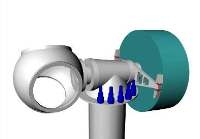REW Exclusive: Siemens New 3.6 MW Direct-drive "Concept" Wind Turbine
Will direct drive bring down the cost of energy from large-scale wind turbines? Next week, Siemens Energy will install a highly innovative 3.6-megawatt (MW) direct drive "concept" turbine at a location near Ringkoebing, Denmark, where it will undergo a two-year test period. Renewable Energy World magazine was invited to Denmark to take a look at progress on the assembly of the "concept" and to hear first-hand about Siemens' key strategies and considerations behind this important project.
Featuring a 107-meter rotor, that SWT-3.6-107 has since become one of the company's two top-selling volume products. This huge flagship turbine has also emerged as one of the world's most successful turbines for offshore wind plants. The first 25 offshore turbines became operational in the UK in 2007 and the order book is in the region of 240 units for the coming years. And now Siemens has decided to see how a new, gearless design would fare.
Concept turbine
Chief Technology Officer Henrik Stiesdal explained that he had been working on direct-drive design options since 1999, but project development efforts remained low-key until 2005.
"We have been producing geared wind turbines since 1980 and despite occasional issues over the years we have always been — and remain — happy with the technology. However, we also realize that direct-drive wind turbines may become competitive with geared turbines for large turbine sizes and we want to get hands-on experience with direct-drive technology in order to conclude whether it can be made competitive with geared technology, and if so from what power level. At the end of the day it can be boiled down to the question whether direct-drive technology offers any substantial added value to SWP customers."
The idea behind the Concept turbine is to change only what is essential. It therefore features a standard SWT-3.6-107 rotor and a functionally comparable twin-bearing main shaft support. Also unchanged are the 690-volt generator, full-power converter, control systems and the tower.
Integrating the direct-drive generator into a proven wind turbine system substantially simplifies the testing arrangement.
"It enables our engineers to focus on generator performance, system reliability and cost-effectiveness during the test period," said Stiesdal, explaining why he prefers to speak of a "concept" turbine rather than a prototype.
"This is not a prototype of a new product; it is the physical manifestation of a technology project. If we decide to turn this into a commercial product then we will run as a second stage a classical R&D project, with design optimizations, etc. But I would also like to stress that such decision has not yet been made, and if it is made it may be for a larger machine."
Recognizable
The 1.3-MW and 2.3-MW Siemens turbine models are all clearly recognizable by a characteristic cylindrical cigar-shaped nacelle, and these familiar nacelle lines now reappear in the 3.6-MW "concept." But unlike several other direct-drive turbine makes and models having the generator located in front the tower, Siemens decided for a different solution.
The fully enclosed cylinder-shaped generator unit is supported by the main shaft rear end and is positioned behind the mainframe and tower. In fact, the generator is now located in what is normally the gearbox position in a Siemens turbine. All direct-drive key components fit neatly into the cylinder-shaped nacelle, which has a 6-meter outer diameter, and a length of "only" 13 meters.
 The
fully enclosed air-cooled permanent magnet type generator does not have
much free play inside the nacelle, as its outer diameter is of the order
of 5.5 meters. The two different generators have weights in the 70-75 tons
range, and the length is about 2.5 meters. The generator stator is fitted
to a left and right-hand torque support attached to the integrated bearing
housing. The generator cooling systems and the AC-DC power converter are
all located in the nacelle rear.
The
fully enclosed air-cooled permanent magnet type generator does not have
much free play inside the nacelle, as its outer diameter is of the order
of 5.5 meters. The two different generators have weights in the 70-75 tons
range, and the length is about 2.5 meters. The generator stator is fitted
to a left and right-hand torque support attached to the integrated bearing
housing. The generator cooling systems and the AC-DC power converter are
all located in the nacelle rear.
A second "concept" turbine, featuring a generator of different make, is planned for the test site before the end of the year. UK-based Converteam and the Large Drives Business Unit of the Siemens Industry Sector have each delivered a fully interchangeable generator for one of the two concept turbines.
The "concept" top head mass (combined weight of the nacelle plus rotor) is about 265 tons (nacelle 165 tons; rotor 100 tons) as compared with 235 tons for the SWT-3.6-107. One of Stiesdal's future product development goals, provided direct drive is to stay, will be pushing down top head mass to geared-drive turbine levels through product optimization. That will certainly pose a major challenge.
But the impressive "concept" turbine as it was presented in June 2008 already offers plenty of potential to become a formidable wind technology asset for Siemens in the years to come, reducing the cost of energy over a turbine lifetime of 20 years plus.
Look out for Eize de Vries' in-depth report on the new design in the July/August issue of Renewable Energy World magazine.
 To subscribe or visit go to:
http://www.renewableenergyaccess.com
To subscribe or visit go to:
http://www.renewableenergyaccess.com